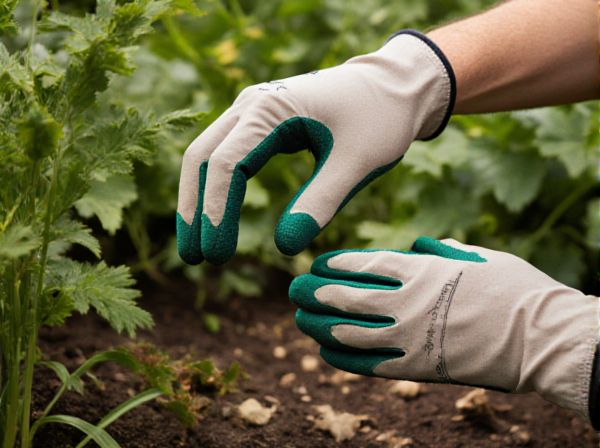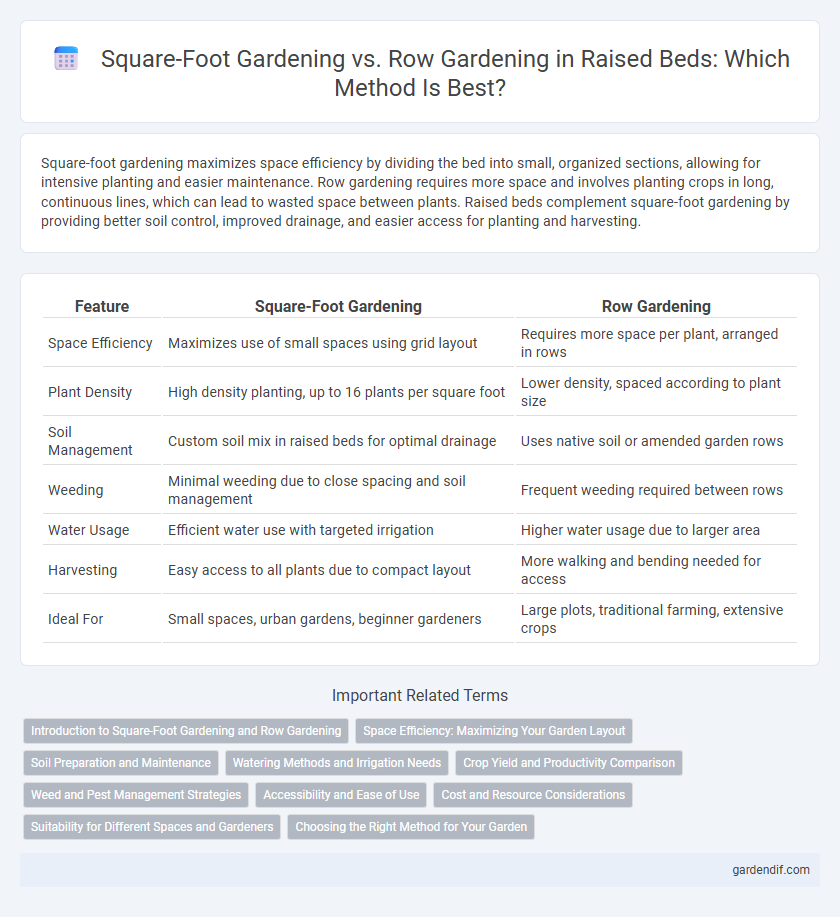
Square-foot gardening vs Row gardening Illustration
Square-foot gardening maximizes space efficiency by dividing the bed into small, organized sections, allowing for intensive planting and easier maintenance. Row gardening requires more space and involves planting crops in long, continuous lines, which can lead to wasted space between plants. Raised beds complement square-foot gardening by providing better soil control, improved drainage, and easier access for planting and harvesting.
Table of Comparison
| Feature | Square-Foot Gardening | Row Gardening |
|---|---|---|
| Space Efficiency | Maximizes use of small spaces using grid layout | Requires more space per plant, arranged in rows |
| Plant Density | High density planting, up to 16 plants per square foot | Lower density, spaced according to plant size |
| Soil Management | Custom soil mix in raised beds for optimal drainage | Uses native soil or amended garden rows |
| Weeding | Minimal weeding due to close spacing and soil management | Frequent weeding required between rows |
| Water Usage | Efficient water use with targeted irrigation | Higher water usage due to larger area |
| Harvesting | Easy access to all plants due to compact layout | More walking and bending needed for access |
| Ideal For | Small spaces, urban gardens, beginner gardeners | Large plots, traditional farming, extensive crops |
Introduction to Square-Foot Gardening and Row Gardening
Square-foot gardening maximizes space by dividing raised beds into compact, organized grids, enabling intensive planting and efficient crop rotation. In contrast, row gardening arranges plants in straight lines with wider spacing, allowing easier access for tilling and harvesting but requiring more land area. Both methods suit raised beds but differ in space utilization, maintenance, and yield optimization.
Space Efficiency: Maximizing Your Garden Layout
Square-foot gardening maximizes space efficiency by dividing raised beds into small, organized sections, allowing intensive planting and higher yields per square foot compared to traditional row gardening. This method utilizes every inch of the garden layout, reducing wasted space between rows and facilitating easy access for maintenance and harvesting. In contrast, row gardening often requires wider spacing for machinery and walking paths, limiting the total number of plants grown in the same area.
Soil Preparation and Maintenance
Square-foot gardening maximizes soil efficiency by dividing raised beds into small, intensively planted sections, minimizing soil disturbance and optimizing nutrient use. Row gardening requires more extensive soil preparation, including deep tilling and larger space allocation, increasing the potential for soil compaction and weed growth. Maintenance in square-foot gardening is simplified through precise irrigation and targeted fertilization, while row gardening demands regular weeding and broader soil amendment to maintain soil health.
Watering Methods and Irrigation Needs
Square-foot gardening requires precise, localized watering methods such as drip irrigation or soaker hoses to efficiently deliver moisture to densely planted areas while minimizing water waste. In contrast, row gardening often utilizes overhead sprinklers or furrow irrigation, which can lead to uneven water distribution and higher evaporation rates. Efficient water management in square-foot gardens supports healthier plant growth and reduces irrigation needs compared to traditional row setups.
Crop Yield and Productivity Comparison
Square-foot gardening maximizes crop yield by allowing dense planting in small, organized plots, optimizing space and nutrient use for higher productivity per square foot. Row gardening, while traditional, often leads to lower overall yield due to wider spacing and less efficient land use, resulting in reduced plant density. Studies show square-foot gardening can increase productivity by up to 30-50% compared to row gardening, particularly in small-scale urban or backyard settings.
Weed and Pest Management Strategies
Square-foot gardening reduces weed growth through densely planted beds that limit open soil exposure, hindering weed seed germination and easing pest monitoring. Row gardening often requires more frequent weed control measures like mulching or herbicide applications due to larger open soil areas that promote weed establishment. Pest management in square-foot gardens benefits from plant diversity and close spacing, which confuses pests and supports beneficial insects, while row gardening may rely more on mechanical controls and targeted pesticide use.
Accessibility and Ease of Use
Square-foot gardening offers enhanced accessibility and ease of use by organizing plants into small, manageable grids ideal for tight spaces and minimizing bending. Raised beds promote ergonomic planting heights that reduce strain, making them suitable for gardeners with limited mobility compared to traditional row gardening. Row gardening often requires more physical effort for soil preparation and maintenance due to larger planting areas and uneven terrain.
Cost and Resource Considerations
Square-foot gardening reduces costs by maximizing space efficiency, requiring fewer seeds, soil amendments, and water compared to traditional row gardening. Raised beds in square-foot gardening minimize soil compaction and weed growth, lowering maintenance expenses and resource use. Row gardening often demands more land, water, and labor inputs, increasing overall resource consumption and initial setup costs.
Suitability for Different Spaces and Gardeners
Square-foot gardening maximizes yield in limited spaces by dividing beds into compact, organized sections ideal for urban gardeners and beginners. Row gardening suits larger areas, offering flexibility for crop rotation and traditional planting methods preferred by experienced gardeners managing expansive plots. Each method's space requirements and maintenance intensity align differently with gardener expertise and available garden size.
Choosing the Right Method for Your Garden
Square-foot gardening maximizes space by dividing raised beds into compact, manageable sections, ideal for small areas and intensive planting of vegetables and herbs. Row gardening suits larger spaces, allowing traditional planting in long, straight lines that facilitate easy access and crop rotation. Selecting the right method depends on garden size, crop variety, and maintenance preferences, with square-foot gardening offering efficiency and row gardening providing flexibility for diverse plant growth.
Square-foot gardening vs Row gardening Infographic

 gardendif.com
gardendif.com